The x86 Power Myth Busted: In-Depth Clover Trail Power Analysis
by Anand Lal Shimpi on December 24, 2012 5:00 PM ESTIdle Power
In all of these tests you're going to see three charts. The first will show you total platform power, measured at the battery, taking into account everything from SoC to display. The next shows you power measured at the CPU power delivery circuit, and the third shows you power measured at the GPU power delivery circuit. All values are measured in watts, and are reported in 15ms intervals (although I sampled at 1KHz then averaged down to 15ms).
For our first set of tests I simply wanted to get a feel for idle power. Both systems had all background syncing suspended, WiFi was connected, and we're just sitting at the Windows RT/8 Start Screen until the tablets reached a truly idle state. Note that idle under Windows RT/8 technically doesn't happen until the live tiles stop updating, which you'll see denoted by a drop in the idle power consumption in the graphs below.
First up is total platform power consumption:
Surface RT has higher idle power, around 28% on average, compared to Acer's W510. The last half of the graph shows the tablets hitting true idle when the live tiles stop animating.
A look at the CPU chart gives us some more granularity, with Tegra 3 ramping up to higher peak power consumption during all of the periods of activity. Here the Atom Z2760 cores average 36.4mW at idle compared to 70.2mW for Tegra 3.
The GPU specific data is pretty interesting - the GPU power rail shows much high power consumption than on Intel's Z2760. As I didn't design Tegra 3, I don't know what else is powered by this rail - although you'd assume that anything else not in use would be power gated. Imagination Technologies' PowerVR SGX 545 does appear to be quite power efficient here, on average using 155mW while rendering the Start Screen.
I wasn't happy with the peaks we were seeing when nothing was happening on the systems, so to confirm that nothing funny was going on I threw both tablets into airplane mode and waited for full idle. Check out the tail end of the platform power diagram:
That's much better. Without the AP talking to each tablet's WiFi radio constantly, idle becomes truly idle. If you're curious, the power savings are around 47.8mW (average) for the W510 in airplane mode when fully idle.
The GPU rail feeding the Atom Z2760 appears to hit a lower idle power when compared to NVIDIA's Tegra 3. Advantages in idle power consumption are key to delivering good battery life overall.


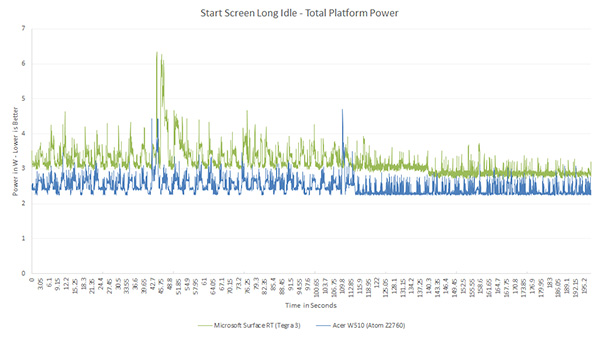
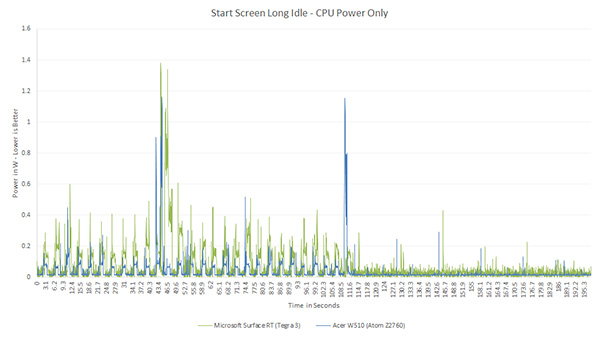
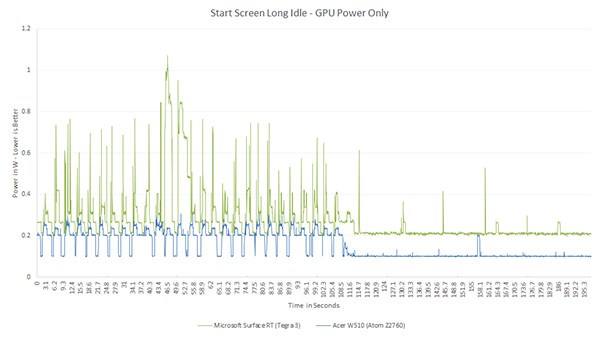

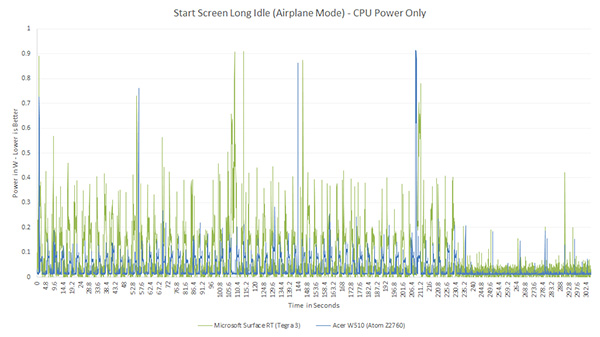
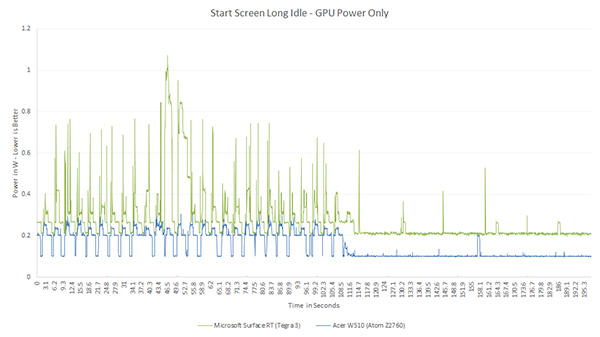








163 Comments
View All Comments
powerarmour - Tuesday, December 25, 2012 - link
This is apples to oranges in some respects, the 5th companion core is disabled in Windows RT for Tegra 3, plus it's GPU is faster than the PowerVR core in the Clover Trail also.sonelone - Tuesday, December 25, 2012 - link
Once an A15 gets put in a Windows tablet, I would like to see an updated comparison.skiboysteve - Tuesday, December 25, 2012 - link
I'm a long time reader and and engineer at national instruments. I have used that usb-6259 and signalExpress many times. Very cool to see it on my favorite siteBeenthere - Tuesday, December 25, 2012 - link
AMD is the one who has been preaching the "User Experience" for years because their products in fact have been delivering a better User Experience when you run real apps and cut thru all the marketing B.S. and tainted benches that Intel spends fortunes on each year to manipulate hacks and consumers.It's no surprise that Intel is now trying to mislead the sheep on power consumption also, seeing as though AMD has had better power saving features in their CPU for years. Naturally Intel and certain hacks will proclaim this as an "Intel breakthrough" when in fact AMD has been leading the way in power reduction consumption in actual use - for years.
It's pretty easy to dupe the naive and gullible and Intel is really good at buying the media reporting they desire be it with ad dollars, invites to "special" events or other "perks" to gain a psychologically favorable interpretation of their latest marketing ruse-of-the-week.
The sheeple will buy into it all hook, line and sinker. If you're that technically challenged, you deserve to get fleeced.
puppies - Tuesday, December 25, 2012 - link
Don't hold back. Tell us how you really feel!Claiming AMD "leads the way" on power consumption and intel just follows is stupid.
Have you been in a coma since "I" series cpus were released. They beat AMDs CPUs on performance, power usage and performance per watt. I'm surprised you can see to type properly with your head that far up AMDs butt.
B3an - Friday, December 28, 2012 - link
It's Beenthere. He posts nothing but THE most stupid sh*t. He takes stupid to another level.I just hope he's mentally retarded in some way because if he's not, and is actually this stupid, then i feel embarrassed for him.
CeriseCogburn - Friday, January 25, 2013 - link
He is just the average amd fanboy. He is what all you'all ( u know whom ui r) have been for years here, he has just kept hanging on this past few months or half year instead of moving with the masses politically correct mindset change.Thus, we should all treat him as any other recently yet former and now scared to remain the same amd fanboy should be treated.
He was the majority here, he still is the majority here, he's just the last one with the guts to keep the charade going... perhaps forever. A nice landmark outlining the years of abuse the amd fanboys have delivered. Hopefully he will never change, a solid reminder and future melding point for the large amd fanboy base that will re-emerge ASAP when some opportunity presents.
yyrkoon - Tuesday, December 25, 2012 - link
Maybe on some level what you're saying is true but I find that both brands have their uses Depending on what a user wants / needs.Mostly the distinction I find is value vs reliability. Intel being slightly more reliable, while AMD offers more value. In this day and age, I think it is a mixed bag on which is more power efficient between the two.
It is hard to claim that AMD is more power efficient compared to Intel when AMD is offering 60w, 90w, and 120w desktop TDPs, where Intel is offering 35w, 45w, and 90w TDP variants. In the mobile arena, there is less distinction.
skiboysteve - Tuesday, December 25, 2012 - link
I'm a long time reader and I'm an engineer at national instruments. Very cool to see our stuff show up in an article!Tunnah - Tuesday, December 25, 2012 - link
I don't normally post comments, as I'm not smart enough to be able to figure into the usual conversations here, but I just had to post this to say this is an absolutely amazing article.I'm a high school drop out from the age of 15 with no further education, all my teaching has been done on my own accord, so what I know isn't indepth, it's just the broad strokes. I
I just wanted to let you know that your articles help me so much in my quest to educate myself, they're absolutely AMAZING, so easy to understand, and although I can only grasp the concepts of the things you're talking about, you propose them in a way where it doesn't go over my head.
I suppose this is just a drunken thank you message from a very grateful reader, who, without you, would be a lot more clueless about the things he really wants to understand :)